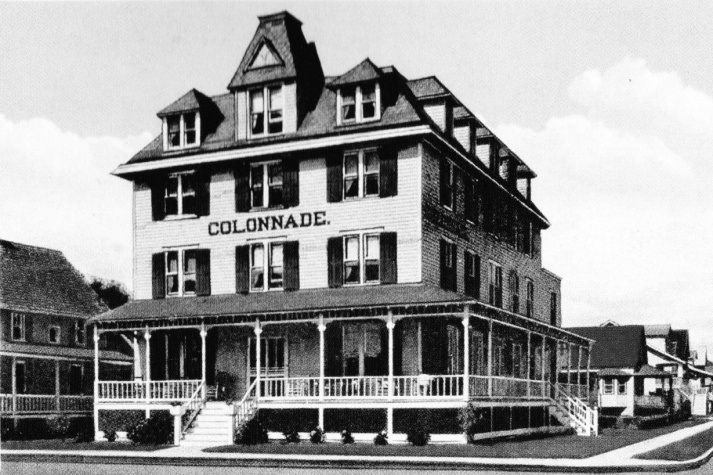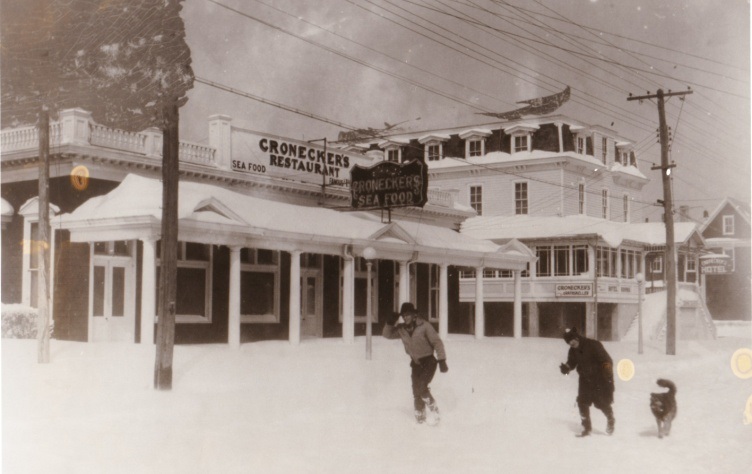Cronecker's was a popular hotel and eatery.
 By Bob Thibault
By Bob Thibault
Sea Isle City was created to be a tourist destination. To accommodate the horde of anticipated early visitors, the city saw the construction of 30-plus hotels before the end of the 19th century – only a decade or so after Charles Landis started to develop his island into a resort to be reckoned with.
The collage of ads shown below from an 1889 newspaper gives an idea of the town’s burgeoning hospitality industry.
Advertising hasn’t changed much over the years. Descriptors such as “magnificent,” “unexcelled,” and “first class” were scattered throughout the hotel ads.
Everyone claimed they had “reasonable rates” and provided an “excellent table.” Accommodations went for about $2 a day. Meals cost around 50 cents or so, and it was said that no one ever left hungry – or thirsty. One report stated that there were 34 establishments in town that sold alcoholic beverages.

Visitors had many hotel choices in the shore town.
Many hotels were concentrated in the downtown area between 39th and 44th streets, a short walk from the West Jersey train station. Others were located along the shore to take advantage of their proximity to the wide and happening beach, and to nearby Excursion House, the Ocean Pier and other diversions.
According to the Pennsylvania Railroad, 1,860 guests could be accommodated comfortably.
The hotels shared common traits. They built them as high as they could to provide panoramic views and to catch the summer breezes. They included covered wraparound porches, sometimes more than one. They generally provided meal service with the emphasis on local seafood. In keeping with current architectural style and to gain even more height, many stuck decorative towers or cupolas at the top. Very few had open decks as we know them today.
Of all the early establishments, two stand out. One was easily the most grandiose, and the other the most popular and iconic.
The Continental
The Grande Dame of hotels in early Sea Isle (or in any era for that matter) was the Continental, built in 1889 at 25th Street and the beach. With its 200-foot ocean front, it covered a two-acre footprint with five stories and 400 feet of wide piazzas.
It boasted amenities suitable for a small palace of its time – elegant parlors and dining areas, a glass-enclosed solarium, warm and cold saltwater baths, bell hops, and even brass cuspidors. Plus, it claimed to have the only steam-powered elevator in Cape May County. In 1890, rooms started at $3 a day.

Cronecker's was a popular hotel and eatery.
Cronecker’s Bellevue
It wasn’t as grandiose or as elegant as the Continental, but Fritz and Caroline Cronecker’s Bellevue Hotel (later called “Cronecker’s”) was probably the most iconic in Sea Isle. Built in the late 1880s between 40th and 41st Streets on Landis Avenue, it was owned and managed by the Cronecker family until it was demolished in 1965. It had no air conditioning or other modern conveniences, but relied on comfort, fellowship and fine food to serve its 10,000 visitors each summer. There was a rathskeller in the basement, and later they added a cafe next door, which made it the most popular eating place in town.
Where did they all go?
First, not all of them went. The restored Colonnade still stands, as does the Philadelphia House with its name changed to the familiar “Ocean Drive.”
But in general, the nineteenth century hotels are gone. Business had dwindled, precipitated at least in part by the availability of new summer cottages throughout the town.
The hotels became too expensive to maintain and repair, especially in the face of Sea Isle’s coastal storms. Some were simply torn down to save on taxes. Some, such as Busch’s and the Tivoli, were gutted by fire.
Eventually, the old hotels became superfluous and succumbed to unavoidable economic stress. It was the end of an era.
To browse through photos and literature of the early hotel era in Sea Isle, visit the Sea Isle City Historical Museum at 48th Street and Central Avenue. Access the website at www.seaislemuseum.com. Call 609-263-2992 with any questions. Current hours are 10 a.m. to 3 p.m. Monday, Tuesday, Thursday, and Friday.
Bob Thibault is a member of the Sea Isle City Historical Society. Photos provided Courtesy of Sea Isle City Historical Museum.

Busch’s was gutted by fire.
 By Bob Thibault
Sea Isle City was created to be a tourist destination. To accommodate the horde of anticipated early visitors, the city saw the construction of 30-plus hotels before the end of the 19th century – only a decade or so after Charles Landis started to develop his island into a resort to be reckoned with.
The collage of ads shown below from an 1889 newspaper gives an idea of the town’s burgeoning hospitality industry.
Advertising hasn’t changed much over the years. Descriptors such as “magnificent,” “unexcelled,” and “first class” were scattered throughout the hotel ads.
Everyone claimed they had “reasonable rates” and provided an “excellent table.” Accommodations went for about $2 a day. Meals cost around 50 cents or so, and it was said that no one ever left hungry – or thirsty. One report stated that there were 34 establishments in town that sold alcoholic beverages.
By Bob Thibault
Sea Isle City was created to be a tourist destination. To accommodate the horde of anticipated early visitors, the city saw the construction of 30-plus hotels before the end of the 19th century – only a decade or so after Charles Landis started to develop his island into a resort to be reckoned with.
The collage of ads shown below from an 1889 newspaper gives an idea of the town’s burgeoning hospitality industry.
Advertising hasn’t changed much over the years. Descriptors such as “magnificent,” “unexcelled,” and “first class” were scattered throughout the hotel ads.
Everyone claimed they had “reasonable rates” and provided an “excellent table.” Accommodations went for about $2 a day. Meals cost around 50 cents or so, and it was said that no one ever left hungry – or thirsty. One report stated that there were 34 establishments in town that sold alcoholic beverages.
 Visitors had many hotel choices in the shore town.
Many hotels were concentrated in the downtown area between 39th and 44th streets, a short walk from the West Jersey train station. Others were located along the shore to take advantage of their proximity to the wide and happening beach, and to nearby Excursion House, the Ocean Pier and other diversions.
According to the Pennsylvania Railroad, 1,860 guests could be accommodated comfortably.
The hotels shared common traits. They built them as high as they could to provide panoramic views and to catch the summer breezes. They included covered wraparound porches, sometimes more than one. They generally provided meal service with the emphasis on local seafood. In keeping with current architectural style and to gain even more height, many stuck decorative towers or cupolas at the top. Very few had open decks as we know them today.
Of all the early establishments, two stand out. One was easily the most grandiose, and the other the most popular and iconic.
The Continental
The Grande Dame of hotels in early Sea Isle (or in any era for that matter) was the Continental, built in 1889 at 25th Street and the beach. With its 200-foot ocean front, it covered a two-acre footprint with five stories and 400 feet of wide piazzas.
It boasted amenities suitable for a small palace of its time – elegant parlors and dining areas, a glass-enclosed solarium, warm and cold saltwater baths, bell hops, and even brass cuspidors. Plus, it claimed to have the only steam-powered elevator in Cape May County. In 1890, rooms started at $3 a day.
Visitors had many hotel choices in the shore town.
Many hotels were concentrated in the downtown area between 39th and 44th streets, a short walk from the West Jersey train station. Others were located along the shore to take advantage of their proximity to the wide and happening beach, and to nearby Excursion House, the Ocean Pier and other diversions.
According to the Pennsylvania Railroad, 1,860 guests could be accommodated comfortably.
The hotels shared common traits. They built them as high as they could to provide panoramic views and to catch the summer breezes. They included covered wraparound porches, sometimes more than one. They generally provided meal service with the emphasis on local seafood. In keeping with current architectural style and to gain even more height, many stuck decorative towers or cupolas at the top. Very few had open decks as we know them today.
Of all the early establishments, two stand out. One was easily the most grandiose, and the other the most popular and iconic.
The Continental
The Grande Dame of hotels in early Sea Isle (or in any era for that matter) was the Continental, built in 1889 at 25th Street and the beach. With its 200-foot ocean front, it covered a two-acre footprint with five stories and 400 feet of wide piazzas.
It boasted amenities suitable for a small palace of its time – elegant parlors and dining areas, a glass-enclosed solarium, warm and cold saltwater baths, bell hops, and even brass cuspidors. Plus, it claimed to have the only steam-powered elevator in Cape May County. In 1890, rooms started at $3 a day.
 Cronecker's was a popular hotel and eatery.
Cronecker's was a popular hotel and eatery.
 Busch’s was gutted by fire.
Busch’s was gutted by fire.